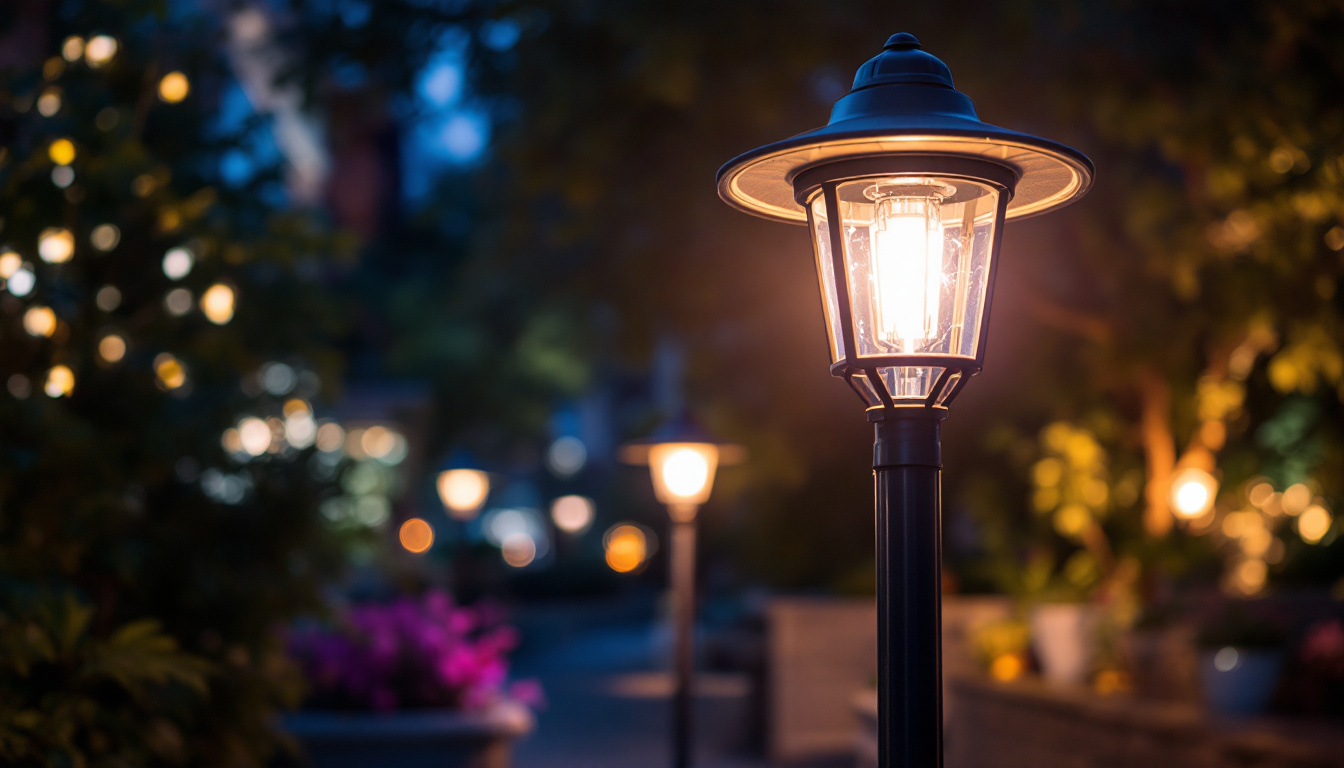
In the world of lighting design and installation, decorative poles play a crucial role in enhancing the aesthetic appeal of outdoor spaces. For lighting contractors, these poles not only serve a functional purpose but also present unique challenges that must be navigated to ensure successful projects. This article delves into the various challenges lighting contractors face when working with decorative poles and offers strategies to overcome them.
Decorative poles are more than just structural elements; they are integral components of landscape design. These poles can be made from various materials, including wood, metal, and fiberglass, and they come in a multitude of styles and finishes. Their primary function is to support lighting fixtures, but they also contribute significantly to the overall aesthetic of a space. In addition to their practical uses, decorative poles can serve as focal points in a landscape, drawing the eye and enhancing the visual appeal of an area. With the right design, they can complement existing architecture or create a striking contrast that adds depth to the environment.
There are several types of decorative poles available, each suited for different applications. For instance, traditional lamp posts often feature ornate designs that evoke a classic feel, while modern poles may have sleek lines and minimalist designs. Some poles are designed with intricate carvings or embellishments, making them suitable for historical districts or themed parks. Understanding the different types available is essential for contractors to make informed decisions that align with their clients’ vision. Furthermore, the choice of material can also influence the longevity and maintenance of the poles, with options like treated wood offering a rustic charm, while metal poles provide durability and resistance to weather elements.
Decorative poles are commonly used in various settings, including parks, streetscapes, commercial properties, and residential areas. Their versatility allows them to enhance the ambiance of outdoor environments, providing both illumination and style. In urban settings, decorative poles can be strategically placed to create inviting pathways and gathering spots, while in residential areas, they can frame driveways or highlight garden features. As a contractor, recognizing the specific needs of each application is vital for selecting the right type of pole. Additionally, incorporating smart lighting technology into these poles can further enhance their functionality, allowing for energy-efficient illumination that can be adjusted based on time of day or occupancy, thus marrying aesthetics with modern convenience.
While decorative poles can elevate a project’s design, they also come with a set of challenges that contractors must address. From installation difficulties to compliance with regulations, understanding these challenges is the first step toward effective solutions.
One of the primary challenges lighting contractors face when working with decorative poles is installation. The poles must be securely anchored to withstand various weather conditions and potential impacts. This often requires specialized equipment and techniques, particularly in challenging terrains or urban environments.
Moreover, the weight and height of decorative poles can complicate the installation process. Contractors must ensure that they have the right tools and manpower to safely install these structures, which may involve additional planning and coordination. In urban settings, the presence of overhead utilities, such as power lines, can further complicate the installation process, necessitating careful planning to avoid any disruptions to existing services. Additionally, contractors may need to coordinate with city officials to obtain permits or schedule work during off-peak hours to minimize the impact on traffic and local residents.
Another significant challenge is navigating the myriad of regulations and codes that govern outdoor lighting installations. Local municipalities may have specific guidelines regarding the height, brightness, and placement of decorative poles. Failure to comply can result in costly fines and project delays.
Contractors must stay informed about local regulations and ensure that their designs meet all necessary requirements. This may involve consulting with local authorities and conducting thorough site assessments before installation begins. Furthermore, contractors should also be aware of any environmental regulations that could affect the project, such as restrictions on light pollution in residential areas or guidelines for protecting local wildlife. Engaging with community stakeholders early in the process can also help mitigate potential objections and foster a collaborative approach to the project.
The choice of materials for decorative poles is crucial, as it directly impacts the durability and maintenance of the installation. Contractors must select materials that not only meet aesthetic preferences but also withstand environmental factors such as moisture, UV exposure, and temperature fluctuations.
Additionally, the maintenance requirements of different materials can vary significantly. For example, wooden poles may require regular treatments to prevent rot, while metal poles might need protective coatings to avoid rust. Understanding these factors helps contractors make informed decisions that will benefit their clients in the long run. In some cases, the use of composite materials may offer a balanced solution, combining the visual appeal of wood with the durability of synthetic options, thereby reducing long-term maintenance costs. Moreover, contractors should consider the lifecycle of the materials chosen, as sustainable options can not only enhance the project’s environmental footprint but also appeal to clients looking for eco-friendly solutions.
Despite the challenges associated with decorative poles, there are several strategies that lighting contractors can implement to ensure successful projects. By being proactive and informed, contractors can navigate potential pitfalls and deliver high-quality installations.
Before commencing any project involving decorative poles, thorough planning and site assessment are essential. Contractors should evaluate the site conditions, including soil type, existing infrastructure, and potential obstacles. This information will inform decisions regarding pole selection, installation techniques, and necessary equipment.
Additionally, creating a detailed project timeline can help ensure that all aspects of the installation process are accounted for, reducing the likelihood of unexpected delays. By anticipating potential challenges, contractors can develop contingency plans that will keep the project on track.
Working closely with manufacturers of decorative poles can provide contractors with valuable insights and resources. Manufacturers often have extensive knowledge about their products, including installation best practices and maintenance requirements. By leveraging this expertise, contractors can make more informed decisions and avoid common pitfalls.
Furthermore, manufacturers may offer training sessions or workshops that can enhance a contractor’s skills and knowledge. Investing time in these opportunities can lead to improved project outcomes and increased client satisfaction.
To navigate the complexities of regulatory compliance, contractors should prioritize staying informed about local codes and regulations. This can involve subscribing to industry newsletters, attending local government meetings, or joining professional organizations that focus on lighting and construction standards.
Establishing relationships with local regulatory bodies can also be beneficial. By fostering open communication, contractors can gain insights into upcoming changes in regulations and ensure that their projects remain compliant.
While overcoming challenges is a critical aspect of working with decorative poles, it is equally important to focus on the aesthetic appeal they bring to outdoor spaces. The right choice of pole can significantly enhance the overall design and functionality of a project.
The design of decorative poles should align with the overall vision of the project. Contractors should consider the architectural style of the surrounding environment and select poles that complement it. For instance, a modern urban landscape may benefit from sleek, minimalist poles, while a historical district may call for ornate, vintage designs.
Additionally, color and finish play a crucial role in the visual impact of decorative poles. Contractors should work closely with clients to understand their preferences and ensure that the selected poles enhance the desired aesthetic.
As technology continues to evolve, incorporating smart lighting solutions into decorative poles can enhance their functionality and appeal. Smart poles equipped with LED lighting, motion sensors, and connectivity features can provide energy-efficient solutions while offering enhanced control over lighting conditions.
Contractors should stay informed about the latest advancements in smart lighting technology and consider how these innovations can be integrated into their projects. By offering clients cutting-edge solutions, contractors can differentiate themselves in a competitive market.
Examining successful case studies can provide valuable insights into effective strategies for overcoming challenges associated with decorative poles. These examples highlight the importance of planning, collaboration, and innovative solutions in achieving successful outcomes.
In a recent urban park revitalization project, a lighting contractor faced challenges related to existing infrastructure and regulatory compliance. By conducting a thorough site assessment and collaborating with local authorities, the contractor was able to design a lighting plan that enhanced the park’s aesthetic while meeting all necessary regulations.
The installation of decorative poles with integrated smart lighting technology not only improved visibility but also provided energy-efficient solutions that aligned with the city’s sustainability goals. This project serves as a prime example of how careful planning and collaboration can lead to successful decorative pole installations.
Another case study involved a lighting contractor tasked with enhancing the lighting in a historic district. The challenge was to select decorative poles that complemented the area’s architectural style while adhering to strict preservation guidelines.
By working closely with preservation experts and utilizing custom-designed poles, the contractor successfully enhanced the district’s charm without compromising its historical integrity. This project demonstrates the importance of understanding the unique challenges associated with decorative poles in sensitive environments.
Decorative poles are essential elements in outdoor lighting design, offering both functional and aesthetic benefits. However, lighting contractors must navigate various challenges, including installation issues, regulatory compliance, and material selection. By employing thorough planning, collaborating with manufacturers, and staying informed about regulations, contractors can overcome these challenges and deliver successful projects.
Moreover, by focusing on the aesthetic appeal of decorative poles and incorporating innovative technologies, contractors can enhance the overall design of outdoor spaces. Through successful case studies, the importance of careful planning and collaboration has been highlighted, showcasing how these strategies can lead to positive outcomes.
As the demand for decorative poles continues to grow, lighting contractors who embrace these challenges and implement effective strategies will position themselves for success in the ever-evolving landscape of outdoor lighting design.
Ready to take on your next lighting project with confidence? At LumenWholesale, we provide lighting contractors like you with the highest quality, spec-grade decorative poles and lighting products at unbeatable wholesale prices. Say goodbye to inflated markups and hello to a vast selection of reliable, high-performance lighting essentials that meet the most rigorous industry standards. Plus, with free shipping on bulk orders, you can stock up on premium lighting solutions at the best value — all without hidden fees or compromises. Enhance the aesthetic appeal of your outdoor spaces seamlessly. Discover wholesale lighting at the best value today and light up your projects with LumenWholesale.

Discover how outdoor pole lights can transform your business strategy and help you secure more lighting contracts.

Discover how King Innovation is revolutionizing lighting projects for contractors with cutting-edge solutions.

Discover how ceiling lights are revolutionizing the lighting industry and becoming the cornerstone of success for contractors.

Discover the key differences between 4000K and 6300K lighting in this essential guide for contractors.